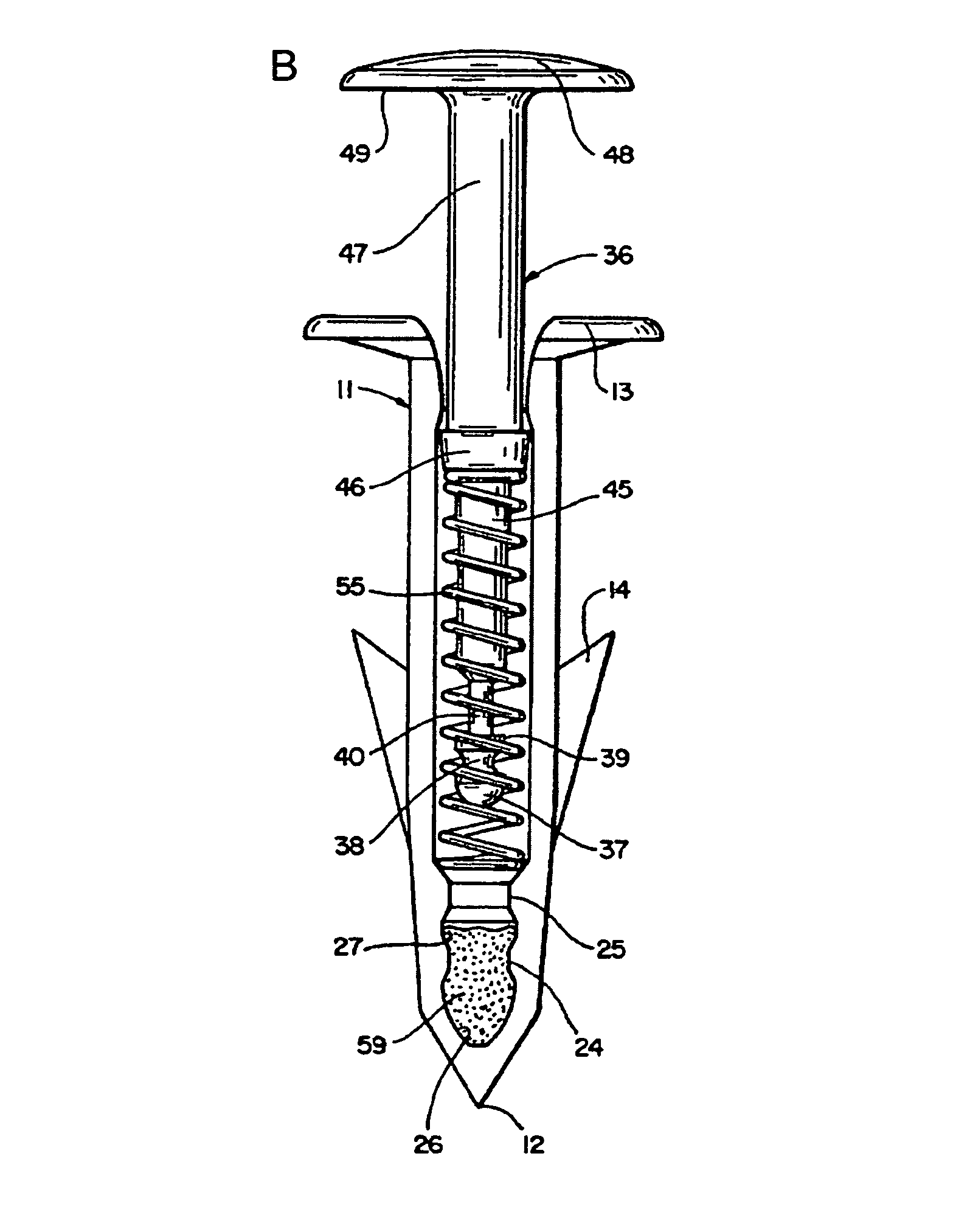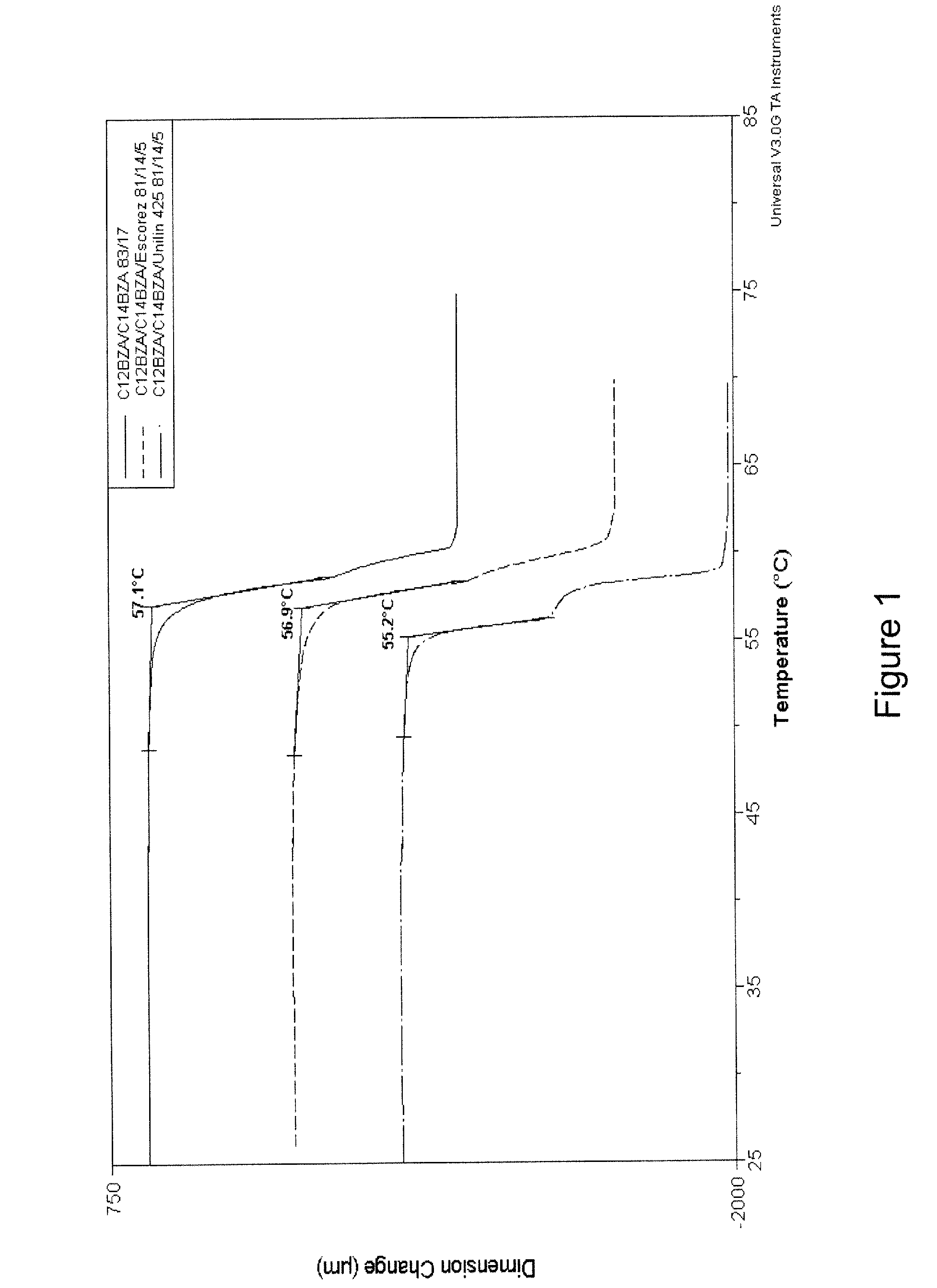Temperature-switching materials having improved strength and thermal properties
a technology of temperature switching materials and thermal properties, which is applied in the direction of temperature measurement in household appliances, polishing compositions, other chemical processes, etc., can solve the problems of inconvenient use in medical or food industries, inconvenient use of low melting eutectic alloys, and inability to meet the requirements of the application of the actuator device, so as to achieve the effect of increasing mechanical strength
- Summary
- Abstract
- Description
- Claims
- Application Information
AI Technical Summary
Benefits of technology
Problems solved by technology
Method used
Image
Examples
example 1
Formulations
[0103]The formulations shown in Table 1 were prepared using standard methods. Transition temperature, spread, and structural integrity data were obtained using the formulations in exemplary disposable temperature indicator devices. Structural integrity was determined using a pull test, wherein the plunger / stem was pulled with a hanging weight while the barrel was secured in a fixed position (see, e.g., U.S. Pat. No. 7,204,199; Volk Enterprises, Inc. (Turlock, Calif.)). Where present, numbers in parenthesis in Table 1 indicate the overall composition of the formulation. Additional information relating to strengthening agents is shown in Table 2.
[0104]DSC and TMA analyses were performed on some formulations using a Universal V3.0G TA Instrument. The results generally agreed with those obtained using the disposable temperature indicator devices. Exemplary DSC and TMA results are shown in FIG. 1-4.
[0105]
TABLE 1Exemplary TSM compositionsDevice PropertiesCompound PropertiesFir...
example 2
Temperature Indicator / Monitoring Device
[0107]An exemplary temperature indicator / monitoring devices is described in U.S. Pat. No. 5,799,606 and illustrated in FIG. 5A-5H. Referring first to FIGS. 5A and 5B, such devices 10 generally include an elongate device / thermometer housing 11 having a pointed tip 12 and a transversely-extending flange 13 formed opposite the tip 12. The upper surface of the flange 13 is preferably substantially planar. A plurality of barbs 14 are formed on the exterior of the housing 11. The shape, size and number of exterior barbs 14 may vary as desired (two are exemplified). The device 10 may be inserted into poultry, meat, or other products by positioning the pointed tip 12 against the product and pressing the thermometer 10 inwardly until the underside of flange 13 engages the outer surface of the product. The barbs 14 securely hold the temperature indicating device 10 in place during storage, handling and cooking of the product.
[0108]The housing 11 is forme...
example 3
Temperature Indicator / Monitoring Device
[0125]Another exemplary temperature monitoring device is described in U.S. Pat. No. 7,204,199 and illustrated in FIGS. 6A-6D. The device 10 includes barrel 12, which is a monolithic molded body made of a material capable of withstanding the elevated temperatures encountered in a cooking environment. Nylon is an exemplary material, although other materials could be adapted for use in the cooking environment as well. The barrel 12 includes lower barrel end 14 adapted for insertion into a food item, and which may be provided with one or more barbs 20 radially disposed near lower barrel end 14 for retaining the temperature monitoring device 10 in the food once inserted. Barrel 12 also includes annular flange 16 located adjacent upper barrel end 18. Flange 16 may be of varying radial dimensions so as to contact the surface of the food item when the device 10 is inserted therein to prevent further insertion.
[0126]Barrel 12 communicates with cavity 24...
PUM
| Property | Measurement | Unit |
|---|---|---|
| melting point | aaaaa | aaaaa |
| molecular weight | aaaaa | aaaaa |
| melting temperature | aaaaa | aaaaa |
Abstract
Description
Claims
Application Information
 Login to View More
Login to View More - R&D
- Intellectual Property
- Life Sciences
- Materials
- Tech Scout
- Unparalleled Data Quality
- Higher Quality Content
- 60% Fewer Hallucinations
Browse by: Latest US Patents, China's latest patents, Technical Efficacy Thesaurus, Application Domain, Technology Topic, Popular Technical Reports.
© 2025 PatSnap. All rights reserved.Legal|Privacy policy|Modern Slavery Act Transparency Statement|Sitemap|About US| Contact US: help@patsnap.com



